October 15th, 2024
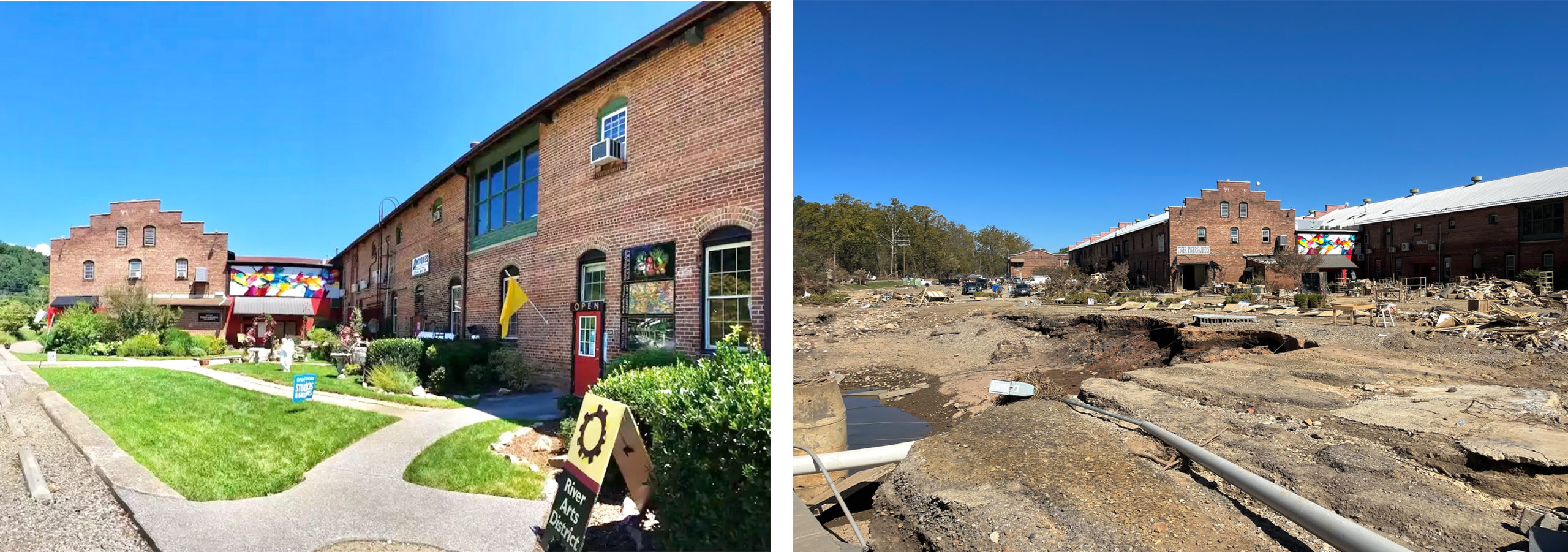
A section of the River Arts District before and after the destruction of Hurricane Helene
A few short weeks ago, Hurricane Helene swept through Asheville, NC, unleashing destruction upon the vibrant River Arts District (RAD), a space renowned for housing the creative works of hundreds of artists. In many ways, one of the most artsy cities in America just lost its creative heart. Among those most affected was our Gallery MAR artist Peter Roux, a seasoned artist whose six-year-old studio at Riverview Station in the River Arts District was obliterated by the floodwaters. The devastation marked the loss of not only countless pieces of artwork but also a cherished creative community.
We at Gallery MAR are doing our part by donating our proceeds from the sales of our current Peter Roux pieces, to the relief efforts in RAD. So pick a painting and help out this community!
For Peter Roux, the River Arts District had long been a place of inspiration. Having moved from the Boston area to Asheville with his family, the District had provided him with the unique opportunity to practice his art full-time in an open studios setting. “The River Arts District gave me the ability to have a really good, solid space in a community of other artists,” Roux recalls. “What’s always been unique about RAD is that you can be a continuous open studio. People are coming through continuously. That vibe was so attractive to people, especially those who had never seen an artist’s studio or talked to artists directly.”
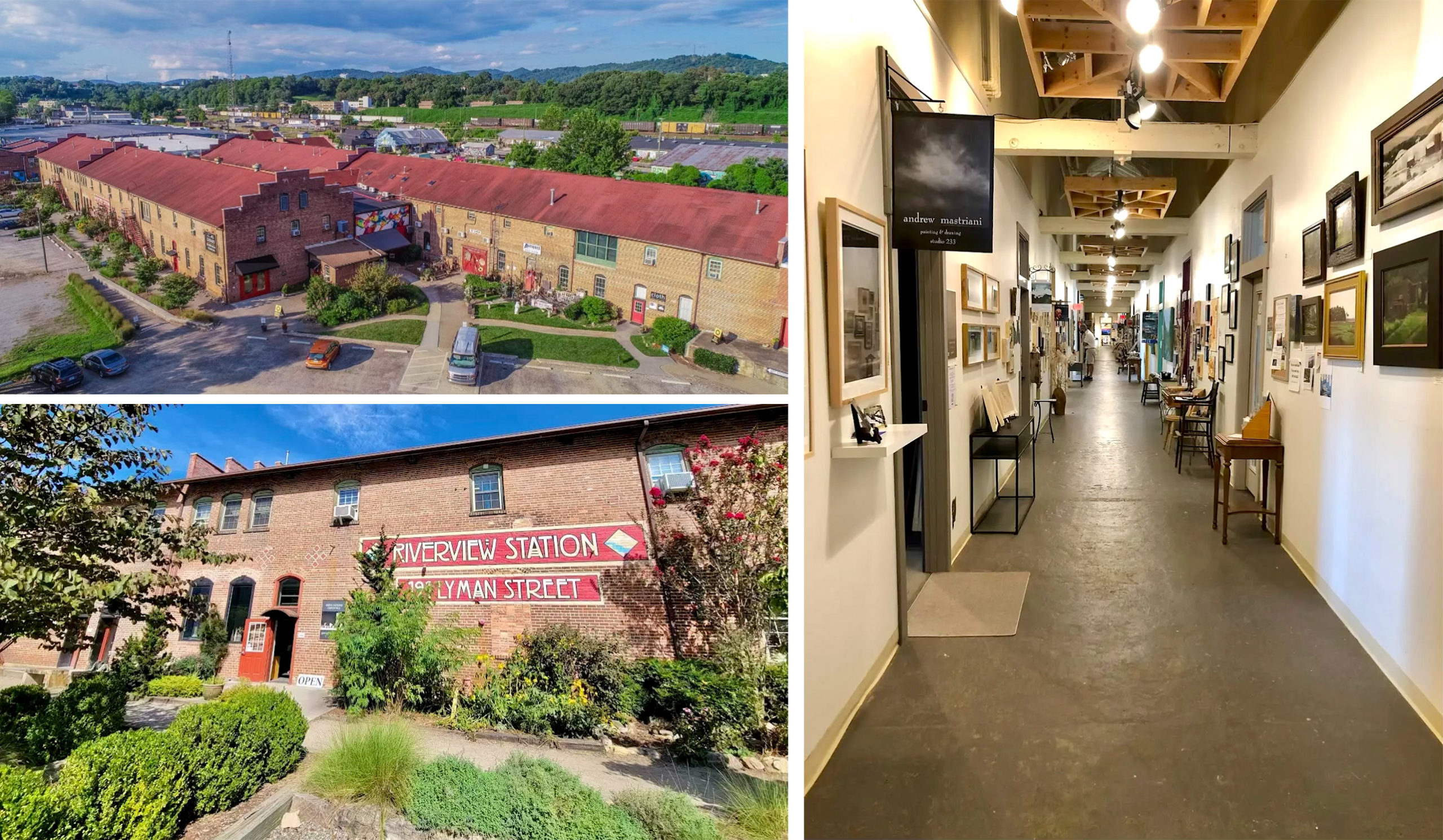
The River Arts District in Asheville before Hurricane Helene
This sense of openness and connection, of vibrant arts in action and on display, is part of what made RAD so special, not just to artists like Roux but also to the many visitors who flocked to the district. Riverview Station, Roux’s studio space, was one of the largest artist buildings, a hub for over 70 working studios. But its proximity to the French Broad River, which swelled to unprecedented levels during the storm, turned it into ground zero for the flood’s destruction.
“The first day I was able to get there, it looked like a war zone. Everything was destroyed, blown up,” Roux said.

The River Arts District in Asheville after Hurricane Helene
For Roux, the storm’s timing was particularly devastating. Just weeks before, he had shipped out a number of his pieces for an exhibition in Eastern North Carolina, narrowly avoiding losing them to the flood. But in the studio, four commissioned works, prepped canvases, and years’ worth of artistic supplies were all submerged. The floodwaters, filled with industrial toxins, left behind black mold and crumbling walls. “The building itself stands only because it’s an old tannery and it’s brick. But on the first floor, it’s incredibly toxic. Walls are crumbling. Anything that was on the ground was destroyed.”
Despite this loss, Roux’s sense of community has been a beacon of hope. “We’ve all been helping each other haul stuff out of our studios and checking in with each other. The sense of community among the artists has been tremendous.” The tragedy revealed the deep connections that had formed within RAD. Artists shared what little supplies they had saved, and volunteers in hazmat suits combed through the toxic remains, working tirelessly to salvage what they could.
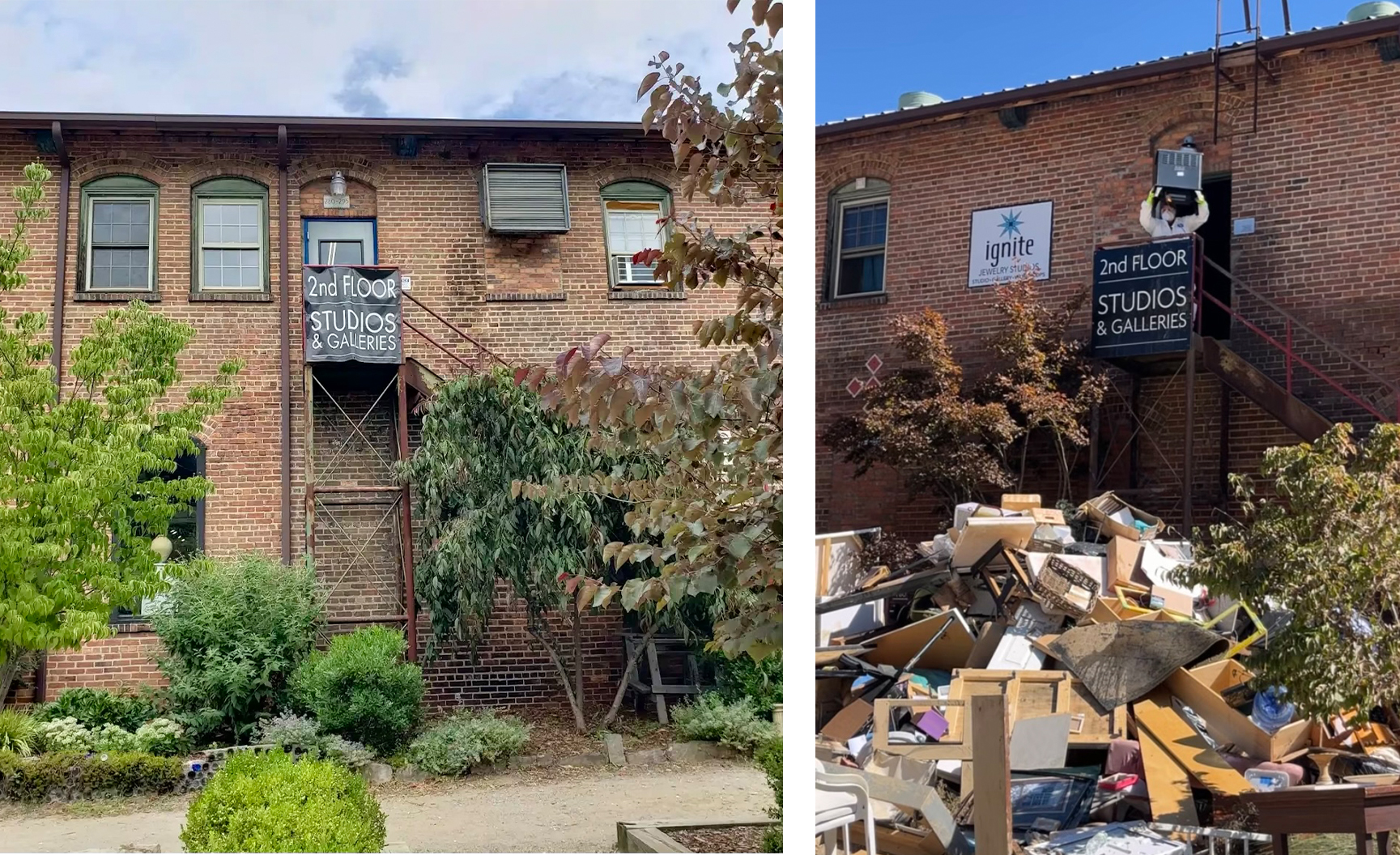
The second floor studios of the Riverview Station in the River Arts District before and after the destruction of Hurricane Helene
The destruction of RAD has also drawn attention to the fact that these artist spaces aren’t just about art—they’re small businesses, deeply personal and irreplaceable. As Roux pointed out, “It’s one thing to lose a traditional business, but there’s something so personal in nature about artistic businesses. It’s just so heartfelt. It’s something I’ve spent my life with. I’ve spent so much time and energy pouring into it, and so did everyone here. Every one of them is a story lost.”
For Roux, moving forward means starting over, an overwhelming reality for many artists in the District. “For the first time in my career, I’m starting over again.” His immediate plan is to set up a temporary studio in his home, but the costs of replacing everything, from brushes to beloved tools like his 20-year-old palette table, are significant. But despite these challenges, Peter finds solace in the overwhelming support he’s received. “The amount of outpouring and support on all levels has been tremendous.”
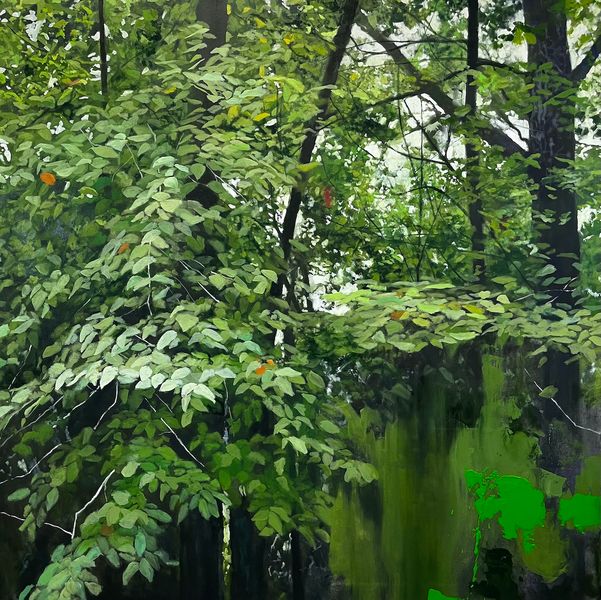
Peter Roux, “A Breath in Pisgah,” oil, 60″ x 60″
So how can people help artists like Peter Roux rebuild? Donations to the River Arts District Artists Association (RADA) are critical. RADA has set up a fund specifically to help affected artists, and contributions go directly to those who need financial support. Additionally, art lovers and collectors can explore RAD artists’ work online through RADA’s website. As Roux points out, “It’s this unique opportunity for art lovers or collectors to discover other RADA artists that they might not have otherwise been aware of, a way to be exposed to new people to add to your collection. I think that that’s a really, really powerful way to help, because psychologically, there’s a power behind the idea that people want to support you and want you to continue doing what you’re doing. Being an artist can feel very isolating, and an event like this can add to that even more, so knowing that there are people out there who want to support you, who would love to see more of what you do, who think what you do is important, can really go a long way. I’ve personally gotten a lot of strength just from hearing from people on that level.”
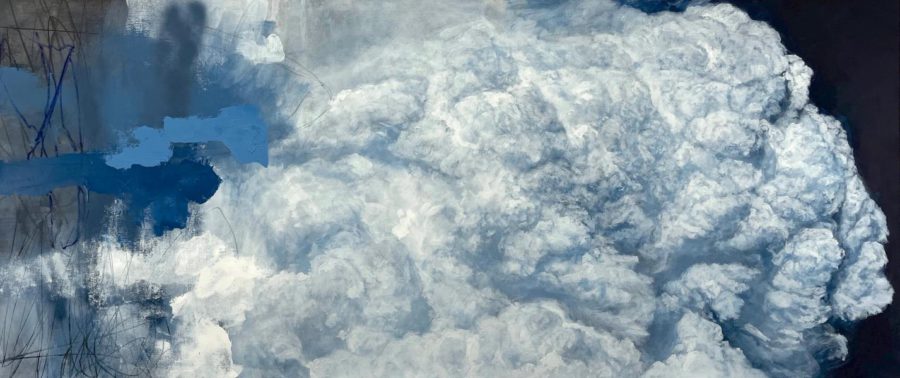
Peter Roux, “Suspension,” oil, 30″ x 72″
For those looking to offer more personal support, there’s now a GoFundMe campaign setup for Peter Roux to help him start over and rise up past this devastation. Plus, here at Gallery MAR, we’re honored to help in some small way by offering 100% of profits from the sale of Peter Roux’s Gallery MAR work to the artist. You can find all four of his stunning works here in the gallery or on our website here.
Despite the losses, Peter holds onto hope. The outpouring of support, the strength of his family, and the sense of resilience within RAD keep him going. “It feels like this will eventually, in ways we probably can’t identify right now, strengthen us in the long run. We just don’t know yet how, but we trust that it will.”
As Asheville begins to recover from the devastation left by Hurricane Helene, the heart of the River Arts District continues to beat. Through the resilience of artists like Peter and the unwavering support of the community, there is hope that RAD will one day rise again, stronger than before.
If you’d like to support the River Arts District and artists like Peter Roux, consider donating to RADA or commissioning work from these incredible creators. Together, we can help them rise from the ruins and find new beginnings.
Written by Veronica Vale
Posted in Gallery News
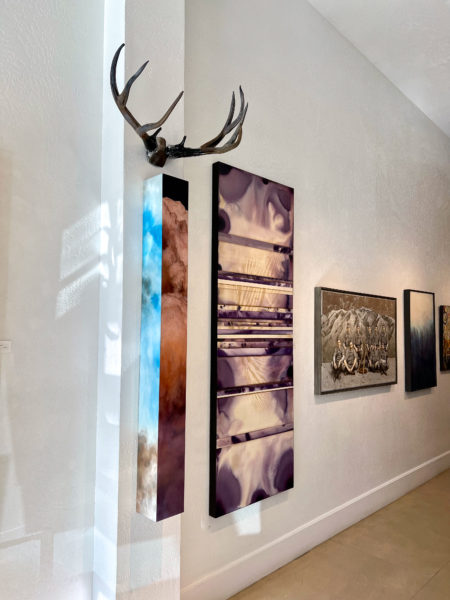
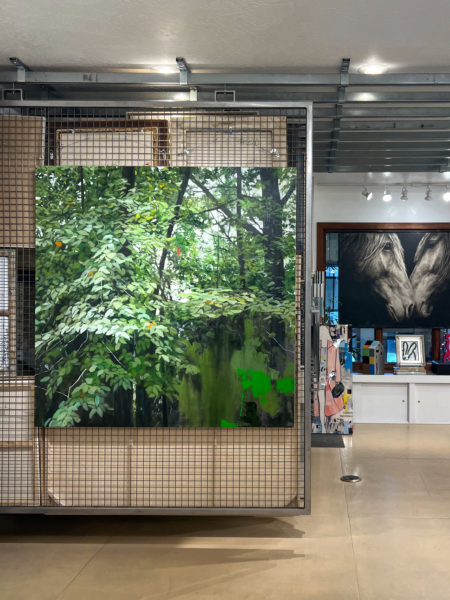

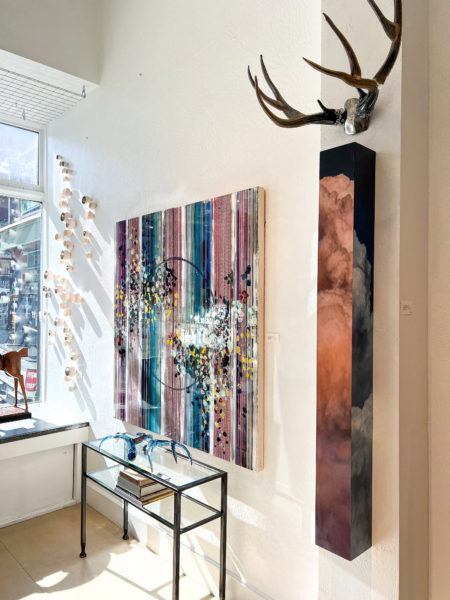
 Picture This: Easter Expressions
Picture This: Easter Expressions Picture This: The Wild West
Picture This: The Wild West Nina Tichava Takes Her Work "To The Sky"
Nina Tichava Takes Her Work "To The Sky"